Fantasia 2016, Days 12 through 14: Afterlife, Life-in-Death, and Madness (We Go On, Aloys, and Therapy)
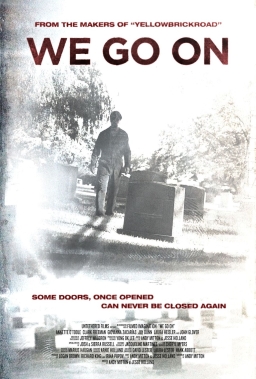 I had errands keeping me away from the Fantasia film festival on Monday, July 25. Now, interruptions are a sad fact of life, but sometimes it’s easy to get back into the swing of things; and as it happened the next day I made it back to the De Sève theatre to watch an American horror film called We Go On, which served to get me back into the Fantasia spirit. Then the day after that I saw two more movies at the De Sève, an odd Swiss romance called Aloys followed by a French horror film called Therapy. The latter had been directed by 16-year-old Nathan Ambrosioni — his second feature film. Together the movies made an odd meditation on life, death, and horror.
I had errands keeping me away from the Fantasia film festival on Monday, July 25. Now, interruptions are a sad fact of life, but sometimes it’s easy to get back into the swing of things; and as it happened the next day I made it back to the De Sève theatre to watch an American horror film called We Go On, which served to get me back into the Fantasia spirit. Then the day after that I saw two more movies at the De Sève, an odd Swiss romance called Aloys followed by a French horror film called Therapy. The latter had been directed by 16-year-old Nathan Ambrosioni — his second feature film. Together the movies made an odd meditation on life, death, and horror.
We Go On was written and directed by Andy Mitton and Jesse Holland (the IMDB credits Holland with “story,” while Mitton gets credit as “writer” as well as for screenplay and story). Miles Grissom (Clark Freeman) is an adult man in Los Angeles suffering from a crippling fear of death. He therefore offers $30,000 to anyone who can prove that there’s life after death — reincarnation, ghosts, anything. Deluged with people who claim to have proof, Miles and his cynical mother (Annette O’Toole) begin a quest to investigate the most promising responses. Things do not go as Miles might have expected.
Nor do things go as the audience might have expected either, and in this case I mean that in the best way. We Go On is thoroughly unpredictable, with an unusual structure and a story that moves between horror and character-based drama. Miles and his mother almost alternate as leads, and one can make a strong argument that the crucial choice shaping how the climax plays out is hers.
More than that, when Miles first gets responses to his offer, he’s able to eliminate most out of hand except for three or possibly four. He then investigates those few contacts one by one; as you might expect he has no luck at first. Also as you might expect his early investigations end up returning to become relevant to the movie later on. But how they become relevant is interesting. In one case it’s plot-related, but another is more thematic, putting forward ideas about fear and the supernatural that inflect the rest of the movie.
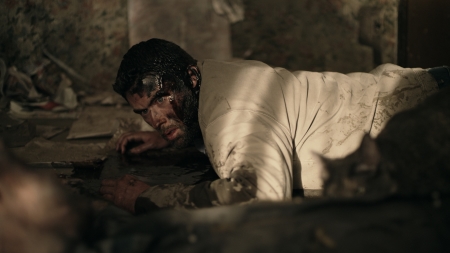 And yet more: the single scariest moment of the film comes maybe halfway through it, a midpoint where things change catastrophically for Miles and the horror really kicks in. But that horror really turns out to be dread, a particular kind of tension that slowly mounts through to the end. And then the end itself goes through several twists that are all well-earned, unexpected actions that make perfect character sense.
And yet more: the single scariest moment of the film comes maybe halfway through it, a midpoint where things change catastrophically for Miles and the horror really kicks in. But that horror really turns out to be dread, a particular kind of tension that slowly mounts through to the end. And then the end itself goes through several twists that are all well-earned, unexpected actions that make perfect character sense.
All of this is to say that the writing here is intelligent and thoughtful. An unashamed genre piece, We Go On looks at genre conventions from unexpected angles. And it has a fair amount on its mind. It’s a movie about death, of course. But it’s also about fear, about facing fear and escaping fear. And, I think, about how people can be trapped in their lives, how cycles of behaviour can perpetuate themselves after life itself ends: the evil that men do lives on and on.
Interestingly, for a movie set in Los Angeles it looks unlike most other LA-set films; the sense of place here is distinctive, but the precise architecture and locations are unusual. In particular, there’s one ghost-town remnant of Old Hollywood that we get to see which both emphasises the nature of the city and also introduces an unusual bit of history into the film. And if, like many cities in the west of North America, Los Angeles has been shaped by growing up after the invention of the automobile, then the movie reflects this in the way it uses the car and Miles’ ability to drive (or lack of same) as not just a plot point but a symbol of his psychological state. Don’t we all sometimes have shadowy ghosts in our back seats?
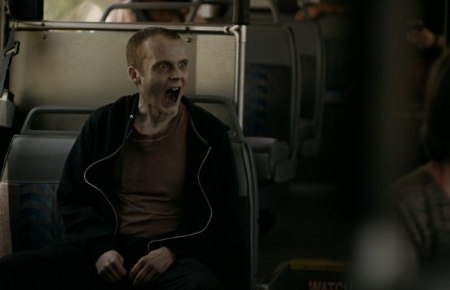 This is all in a way typical of We Go On: it’s bristling with bits of unusual ideas, whether ideas about plot or setting or character. Even the basic idea of a man setting out to unravel the mystery of life after death alongside his unbeliever mother is unusual, an unexpected twist on the buddy movie. But then from another angle the film feels like it could turn into a crime movie at any moment, with fraud and fakery always possible, and a background of violence that slowly emerges as the film proceeds.
This is all in a way typical of We Go On: it’s bristling with bits of unusual ideas, whether ideas about plot or setting or character. Even the basic idea of a man setting out to unravel the mystery of life after death alongside his unbeliever mother is unusual, an unexpected twist on the buddy movie. But then from another angle the film feels like it could turn into a crime movie at any moment, with fraud and fakery always possible, and a background of violence that slowly emerges as the film proceeds.
Anchoring all this is Clark Freeman, who turns in a remarkable performance as Miles. He takes his character through a coherent development that is in some ways the reverse of a typical character arc: beginning as a deeply worried man, after a certain point he becomes increasingly sure of himself. That’s not because of a lack of trauma; indeed rather the opposite. But by not breaking, you can see Miles developing into a stronger person. A scene in a cemetery late in the movie seems to bring this out, as Miles makes a choice he has every reason to believe is both dangerous and morally right. Freeman sells this, and brings out the increasing certainty in Miles just as he earlier brought out Miles’ obsessive fear, and the tension in him between that fear and his attempt to forge a life as a functioning adult.
The path from Miles at the start of the film to Miles at the end is unpredictable, but never feels random. There’s a cool precision underlying the movie even when it’s going in a direction you don’t expect. And for the viewer there’s a pleasure in seeing a satisfying movie that avoids many (though not all) standard plot points. I will give away that it ends with a surprisingly happy ending for a horror movie; in fact if this is a horror movie it’s a deeply unusual one, a horror movie that says there’s nothing to fear.
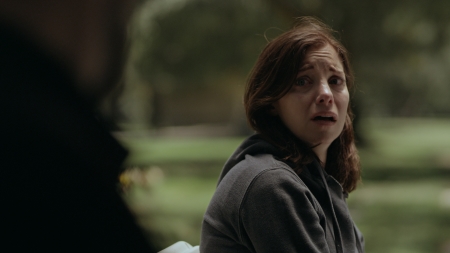 After it ended, writer and co-director Andy Mitton came out to take questions, along with actor Jay Dunn, who played the film’s primary antagonist (I took handwritten notes on the fly). Mitton was asked about the process of co-directing, and he said that it’s really only good if the two directors have a dose of telepathy; otherwise, things tend to get diluted. He and his co-director Jesse Holland went to college together in Middlebury, Vermont, and knew they operated well together. Mitton observed that an auteur has to always listen, and watch the audience for their response.
After it ended, writer and co-director Andy Mitton came out to take questions, along with actor Jay Dunn, who played the film’s primary antagonist (I took handwritten notes on the fly). Mitton was asked about the process of co-directing, and he said that it’s really only good if the two directors have a dose of telepathy; otherwise, things tend to get diluted. He and his co-director Jesse Holland went to college together in Middlebury, Vermont, and knew they operated well together. Mitton observed that an auteur has to always listen, and watch the audience for their response.
Asked if they believed in the afterlife themselves, Mitton said he did, but Holland did not, so that in a way their relationship echoed that of the mother and son onscreen. Mitton said he grew up a believer, and now believes in past lives. Whatever one’s beliefs, he hopes that the central journey of Miles is universal.
Dunn was asked how he prepared for his role, and he said he stuck with what’s on the page, specifically with what his character did and not what he said. Asked how Annette O’Toole was brought on board the film, Mitton said that she worked with Mitton’s wife, who also has a role in the film. This connection was particularly useful, as when an actor originally committed to the film couldn’t make it, O’Toole was able to reach out to John Glover to fill that role. Mitton praised the humour she brought, which he felt was necessary to ground the movie.
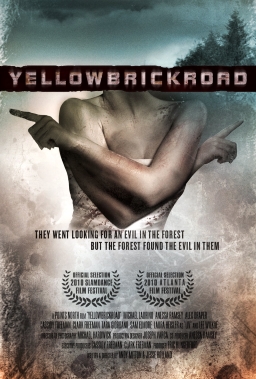 (As an aside, not knowing how John Glover got involved with the film, seeing him playing against Benning I have to admit I did occasionally flash back to Smallville — where Benning played Martha Kent and Glover played the evil Lionel Luthor. This was particularly pronounced when Benning told Glover’s character “Don’t fuck with my son!” Levels of reality were confused, especially as her onscreen son here was played by an actor named Clark.)
(As an aside, not knowing how John Glover got involved with the film, seeing him playing against Benning I have to admit I did occasionally flash back to Smallville — where Benning played Martha Kent and Glover played the evil Lionel Luthor. This was particularly pronounced when Benning told Glover’s character “Don’t fuck with my son!” Levels of reality were confused, especially as her onscreen son here was played by an actor named Clark.)
Dunn was asked about the unusual physical presence he brought to his character, and he said that he played with how to portray his character as somehow off-kilter. Mitton was then asked about the development of the film, and said that he and Holland had been working in short films after their movie YellowBrickRoad, and then had the idea of the central horrific moment of We Go On. Since he didn’t see many mother/adult son duos in movies, they decided to work with that. Mitton said that the LA history mentioned in the film was real, and that they actually had shot as close to the LA airport as it seemed. “Oh yeah, we met some weird people,” he recalled. “They’d probably say the same about us, though.”
A questioner asked about the balance of elements in the film, and Mitton said his primary background was in drama — he loves horror but doesn’t live in horror. He lives where comedy collides with dramatic moments and horror moments. It can be exhilarating to see that on film, he said. Asked then about the death of Miles’ father, alluded to in the movie but not shown, Mitton said he felt that the father suffered from being where Miles started the film; that he was an example of someone who might’ve been saved by knowing what came after death.
That brought the question-and-answer session to a close, and I headed back home. The next afternoon I was back at the De Sève to watch Aloys. A Swiss movie from writer-director Tobias Nölle, it follows a private eye, the titular Aloys (Georg Friedrich), whose father (his partner in detection) has recently died. Aloys Adorn lives a numb life disconnected from the world around him, enlivened only by the videos he records in the course of his investigations and which he rewatches voyeuristically. Until one night his camera’s taken from him, by a woman who leads him to reconsider how he’s living his life.
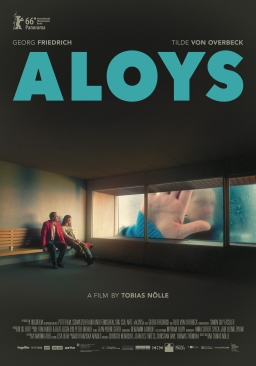 Bluntly, this is a movie about a man redeemed by a not-very-manic pixie dream girl. The culprit behind the stolen camera is Aloys’ neighbour, Vera (Tilde von Overbeck), who for no very obvious reason decides to take it upon herself to break him out of his shell, guiding him by phone through several visualisation exercises. For a detective, Aloys is slow to realise what’s happening; but then realistically he seems to be far too introverted to be able to live as a detective. Of course, he’s not a particularly ambitious detective, handling divorce cases, following people and videorecording them rather than investigating mysteries and deducing things. One might suspect that this is a function of his father’s death, but the film seems to suggest things weren’t much different for him before that.
Bluntly, this is a movie about a man redeemed by a not-very-manic pixie dream girl. The culprit behind the stolen camera is Aloys’ neighbour, Vera (Tilde von Overbeck), who for no very obvious reason decides to take it upon herself to break him out of his shell, guiding him by phone through several visualisation exercises. For a detective, Aloys is slow to realise what’s happening; but then realistically he seems to be far too introverted to be able to live as a detective. Of course, he’s not a particularly ambitious detective, handling divorce cases, following people and videorecording them rather than investigating mysteries and deducing things. One might suspect that this is a function of his father’s death, but the film seems to suggest things weren’t much different for him before that.
Character frequently takes a back seat here to symbolism. This is a movie about a detective, by profession a searcher after truth, being led around by a woman named Vera, a name etymologically linked with truth. In various ways she and the visions she gives Aloys (in a sort of telephonically guided meditation) are linked to nature; so Aloys breaks out of his sterile, rational existence through his love for Vera, or perhaps truth. The symbols here tend to overwhelm the sense of a real story about real characters. I thought this an especial problem in that at one viewing the symbols didn’t seem particularly well-developed, either.
Someone more in tune with the film’s wavelength might have a profoundly different opinion about Aloys than I did. Certainly the visual craft here is impeccable. The composition and framing of the shots are perfect; if Aloys’ world is sterile, it’s also quite beautiful. The colours, the timing of the edits, all are remarkable, and all feel oddly real, as though the camera has just happened to catch the right moment from the right angle. There’s nothing standard here, either in the ‘real world’ or in the internal visions Aloys begins to develop; there’s no hint of commercial gloss, but an idiosyncratic visual sensibility that has crafted a world.
Aloys’ apartment reflects who he is, with a decor apparently frozen decades ago. The urban environment around him is shot in a way that seems to emphasise architecture more than people, emptiness more than fullness. Aloys’ apartment complex encapsulates much of the film’s subtext, a place where many people live together but apart, separated into the enclaves of their individual homes. Aloys himself hides from everyone, staring out through the peephole in his front door when someone bothers him, not answering.
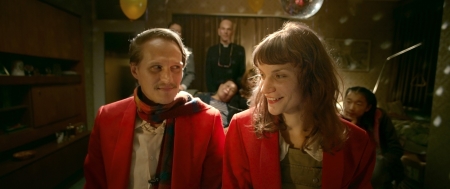 Working with the visual sense of the film is a very terse script. Dialogue’s relatively minimal, which helps allow the images to carry the story. At times I thought more elaboration might have been useful — notably, as I’ve said, in terms of character development. Friedrich certainly does his best, but I feel he overplays Aloys’ introversion, making his character pathetic beyond what the movie seems to imply. It’s difficult (for me at least) not to think that he’s overplaying to give the audience what the script doesn’t provide.
Working with the visual sense of the film is a very terse script. Dialogue’s relatively minimal, which helps allow the images to carry the story. At times I thought more elaboration might have been useful — notably, as I’ve said, in terms of character development. Friedrich certainly does his best, but I feel he overplays Aloys’ introversion, making his character pathetic beyond what the movie seems to imply. It’s difficult (for me at least) not to think that he’s overplaying to give the audience what the script doesn’t provide.
The actual images that Aloys conjures up in his meditations are unpredictable, and do go into some interesting places. At the same time, some of those places don’t make much sense. Ostensibly Vera’s trying to lead him out of his introversion, but her tactics seem to usher him more deeply into a dissociation from reality. Had that been emphasised, it might well have been possible to read the movie as a kind of subversion of manic pixie dream girl stories: the MPDG as danger, even as camouflaged emotional abuser. But Aloys doesn’t go that far. As I read the ending, it’s meant to be touching — but in fact suggests that Aloys has traded in his obsessive fastidiousness for obsessive devotion to Vera.
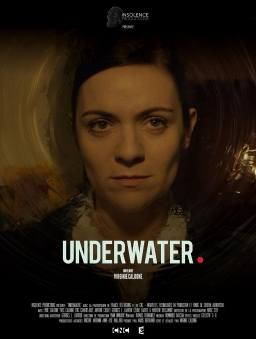 Personally I found the arid, characterless nature of the movie tended to alienate me from its symbolic content. It’s difficult to take a movie’s ideas about life seriously when it can’t seem to create a semblance of life on the screen. In this case I’d say the matter’s worse because the ideas behind Aloys are banal, and they’re wedded to a conventional plot structure. The visual imagination behind the picture is memorable, though, and as I say I can imagine someone even slightly more engaged with the film’s ideas having a much more positive reaction to it.
Personally I found the arid, characterless nature of the movie tended to alienate me from its symbolic content. It’s difficult to take a movie’s ideas about life seriously when it can’t seem to create a semblance of life on the screen. In this case I’d say the matter’s worse because the ideas behind Aloys are banal, and they’re wedded to a conventional plot structure. The visual imagination behind the picture is memorable, though, and as I say I can imagine someone even slightly more engaged with the film’s ideas having a much more positive reaction to it.
After Aloys came Therapy, from writer/director prodigy Nathan Ambrosioni. I met him last year when Fantasia screened his first film, Hostile, and was happy to see him again in 2016 as he brought his sophomore feature to the festival. He’d created Hostile at age 12; what then had he made now, at the ripe old age of 16?
Before getting to his feature a short film showed, “Underwater,” directed and written by Virginie Caloone. A group of cops have bugged a suspect’s house. They think a kidnapped child’s in there, but they need a reason before they can bust down the door. Enter a woman with a remarkable sense of hearing, capable of picking out the slightest sounds. It’s a visually strong movie with a real air of tension. Dramatic lighting and imaginative special effects give the story a bit of distinction.
Therapy begins with teenagers exploring a graffiti-covered ruined building and coming to a bad end at the hands of a mysterious threatening figure. Then we’re introduced to some police officers who’ve recovered film footage left behind by another group of tourists who disappeared after a camping trip. It turns out that the tourists found a mysterious graffiti-covered ruined building. When one of them vanished, the others looked for her in the vast abandoned structure. One of them (played by Ambrosioni) was a film buff, who always carried a camera and had one of the others take a camera as well. Can the police figure out what happened to them from the footage they’ve found?
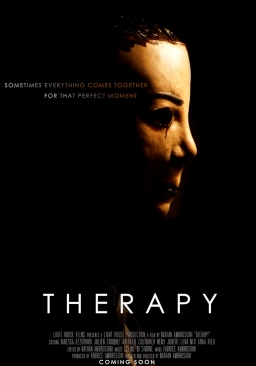 The movie unfolds in the past and the present, with the two tracks dovetailing at the end. Like Ambrosioni’s first film, this is an unapologetic horror movie that revels in sheer genre energy, in the frissons that come from seeing a group of unarmed souls splitting up to explore a vast building in which a remorseless killer waits. One of the first lines from the group of tourists is about telling ghost stories around a fire, and exactly that is what this movie is about: the joy of sudden terror.
The movie unfolds in the past and the present, with the two tracks dovetailing at the end. Like Ambrosioni’s first film, this is an unapologetic horror movie that revels in sheer genre energy, in the frissons that come from seeing a group of unarmed souls splitting up to explore a vast building in which a remorseless killer waits. One of the first lines from the group of tourists is about telling ghost stories around a fire, and exactly that is what this movie is about: the joy of sudden terror.
And Ambrosioni tells a mean tale. The plot moves forward smoothly. One might wonder why the hunted tourists don’t spend more time looking for weapons, but one could easily argue that any possible weapons had been cleared away by the bad guy before the story started. One might also wonder at the near-supernatural efficacy of said baddie, but then he’s presumably had lots of practice. In fact the characters caught up in the horror react believably, running around in just exactly the right ways to find what is for them exactly the wrong thing at the wrong time.
The film gets across the sheer glee of horror storytelling. Do you want a story about young people chased by a masked madman? Here it is. The use of a second level of story, the police seeking answers, makes for a nice bit of contrapuntal plotting and allows for a solid if somewhat ambiguous ending. More than that, the way the story’s told is interesting on a formal level. The movie uses jump-scares extensively, which are usually considered something of a cheap trick. Here, though, something unusual happens. The whole movie’s about people running around a ruined building; a ruined mental hospital, in fact, hence the title. Of course there are going to be a ton of jump-scares in a story like that. So many, in fact, that the scares become a kind of rhythmic technique, a feature of the film’s structure and pacing.
You could reasonably argue that that’s the sort of thing you get from a young creator: taking a formal characteristic often considered to be inherently flawed, and finding a new way to use it, a way to redeem it, to make clear what’s cool about it. In any event, it’s a part of the breathless movement of the film. Ambrosioni’s got a great sense of timing, and the film speeds up and slows down in just the right spots. And we get just enough glimpses of horror at just the right moments to create not just fear but real unease. There is a musical sense to the film, in the rise and fall of tension and the beats of the jump-scares; it’s a symphony of terror, as somebody described another horror film a very long time ago.
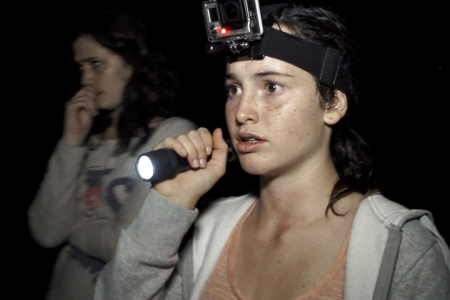 Visually, Ambrosioni leans heavily on the conceit of his characters having cameras always to hand. There are valid enough reasons for this, but the point is that he cuts between different kinds of images with different kinds of lighting. Again, that becomes part of the feel of the film, establishing who we’re with at any given moment at a glance, and moving from darkness to … well, low-light images, at least.
Visually, Ambrosioni leans heavily on the conceit of his characters having cameras always to hand. There are valid enough reasons for this, but the point is that he cuts between different kinds of images with different kinds of lighting. Again, that becomes part of the feel of the film, establishing who we’re with at any given moment at a glance, and moving from darkness to … well, low-light images, at least.
The frame story with the police then has a different feel again. It’s a necessary relief from the unending terror of the main story, but it also shows what Ambrosioni can do with more standard film techniques. There’s one particular conversation at the police station, filmed in the reflections on a tabletop, which is haunting and unsettling in an almost lyrical way, a tone that deepens and broadens the texture of the film as a whole.
The acting is solid, from a cast of both trained and untrained actors, some of whom appeared in Ambrosioni’s first film. It’s fair to say that this is not a character-centric film, but everyone does their job well enough; there’s just the right amount of believability here, enough to draw the audience in. The most important role, of the character who turns out to be in league with the baddie when you don’t expect it (much), is brought off particularly well, giving the film’s final moments the feel of a solid resolution.
Therapy may be the most joyful genre piece I saw at Fantasia, one of the movies most filled with sheer storytelling energy. It’s also one of two movies (along with The Lure) that inspired a special kind of reaction in me: a momentary dizziness when the lights came up at the end, a startled blinking as I wondered where I was and reminded myself I was after all in a movie theatre. I`m not entirely sure why this film affected me that why, much less why this film and something as different from it as The Lure. Some of it is surely the pacing. But some of it I think is just that narrative energy, that wholesale involvement of the storyteller with the story.
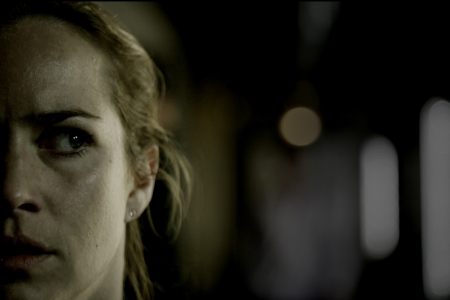 This should not be mistaken for unsophistication. Nor do I think it`s an exclusive property of youth — some of the same energy’s surely also visible in Terraformars or In A Valley of Violence, to say nothing of Holy Flame of the Martial World. In fact it reminds me slightly of the crackling power of the best of the old pulps, although in the form of a distinctively cinematic energy, something that comes from movement, indeed from the motion inherent to moving pictures. I will say that if there’s anything like Therapy in another medium, it’d have to be some of the old EC comics short stories. The sheer glee of gore and terror is much the same, and perhaps the same mixture of formal command and narrative conventions. It’s not a movie for deep ponderings. It’s a movie for putting on when Halloween draws near and you want to be scared, a movie that takes the campfire ghost story and plays it out in digital high definition.
This should not be mistaken for unsophistication. Nor do I think it`s an exclusive property of youth — some of the same energy’s surely also visible in Terraformars or In A Valley of Violence, to say nothing of Holy Flame of the Martial World. In fact it reminds me slightly of the crackling power of the best of the old pulps, although in the form of a distinctively cinematic energy, something that comes from movement, indeed from the motion inherent to moving pictures. I will say that if there’s anything like Therapy in another medium, it’d have to be some of the old EC comics short stories. The sheer glee of gore and terror is much the same, and perhaps the same mixture of formal command and narrative conventions. It’s not a movie for deep ponderings. It’s a movie for putting on when Halloween draws near and you want to be scared, a movie that takes the campfire ghost story and plays it out in digital high definition.
Ambrosioni came out for a question-and-answer period after the film (these notes were not only taken by hand, but in many cases are also often translations from French; I want to give extra warning that infidelities may have crept in). Ambrosioni began by noting that it was a pleasure to be back for Fantasia. Much of Therapy had been shot in the summer before he came to last year’s Fantasia, and the experience had motivated him to finish the film for this year’s festival. Asked about the scene which showed only the reflections of the actors, Ambrosioni said it was an improvised decision — he’d decided it on the day of filming, and thought it looked good. (He said there was no particular significance to shooting it the way he did, but even so in retrospect it’s hard not to take it as a hint that things are topsy-turvy. Sometimes the things that artists instinctively decide work do so because they have perfectly coherent meanings the artists don’t intend.)
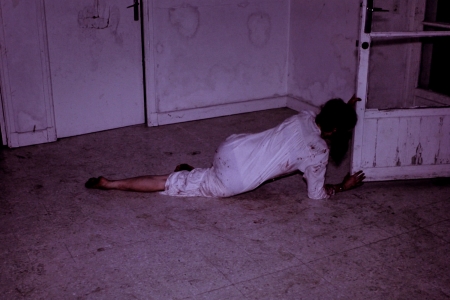 Asked about his inspiration for the film, Ambrosioni said that he visited the place shown on screen and had the idea of doing a film about people trying to escape the place. He said he gets ideas from his home in Nice and from everywhere around him. Asked about the structure of the film, he said it originally ended with one character, but that he felt that ending wasn’t right; the use of the parallel story helped push the ending to what he wanted. Asked about the filming location, he said it was shot in the house as it was shown on film, and that it was as creepy as it looked, but that it was actually complicated to get permission. For his next project, he said he’d like to do a film with an actual budget. He hopes to have another feature in two years, but for the moment is doing a non-horror short film, among other projects.
Asked about his inspiration for the film, Ambrosioni said that he visited the place shown on screen and had the idea of doing a film about people trying to escape the place. He said he gets ideas from his home in Nice and from everywhere around him. Asked about the structure of the film, he said it originally ended with one character, but that he felt that ending wasn’t right; the use of the parallel story helped push the ending to what he wanted. Asked about the filming location, he said it was shot in the house as it was shown on film, and that it was as creepy as it looked, but that it was actually complicated to get permission. For his next project, he said he’d like to do a film with an actual budget. He hopes to have another feature in two years, but for the moment is doing a non-horror short film, among other projects.
Asked about crowdfunding, Ambrosioni said he found it difficult. He did it for Therapy to get money for mixing, but it was hard to run the campaign. Finally, asked about the relative lack of graphic gore on the screen, Ambrosioni said it (along with much else in the film ) was done that way largely for budget reasons. Everything they shot for the film went into it.
That ended the night, and I headed home. It had been a good couple of days. I’d seen genre stretched in different directions, then seen an enthusiastic use of solid horror conventions. We Go On had used genre ideas intelligently and in new ways, Aloys used a nominally genre story as a way to try to get at interesting formal ideas, and Therapy showed the sheer joy there can be in genre storytelling. The films varied in how much they tried to say, and how accomplished I thought they were. But together they seemed to show the storytelling power of genre. With two more movies on the schedule for tomorrow, it was a good way to get back into the swing of the festival.
(You can find links to all my Fantasia 2016 diaries here.)
Matthew David Surridge is the author of “The Word of Azrael,” from Black Gate 14. You can buy his first collection of essays, looking at some fantasy novels of the twenty-first century, here. His second collection, looking at some fantasy from the twentieth century, is here. You can find him on Facebook, or follow his Twitter account, Fell_Gard.